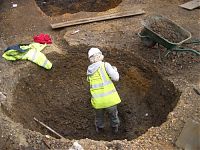Field Officer's report for 21st April 2008
Posted under: journal >> Reports- By: Chaz Morse |
- Apr 21, 2008
- Share
- del.icio.us

After recording and removing the remains of the terraced housing from the South Tenter Street side of the site, a number of earlier post medieval features were revealed. The majority of these were drainage features such as soak away’s and horn core pits. Their frequency is indicative of the rapid population growth in the area during the post medieval period, given that they would be required to deal with the influx of people. During their construction these drainage features were cut through large dumped deposits of made ground, seemingly brought in to work as capping and levelling deposits to create an even surface. This would allow the area of the site to be built upon, and can be seen as a precursor to the development in the later post medieval period.
The site area would have required levelling due to the extensive quarry pitting that had occurred in order to retrieve the sands and gravels that form the natural geological deposits of the region. Such aggregates would have been used as building materials, and it is possible that the extensive use of them points to large scale building programmes at the time of their extraction. The quarrying is demonstrated on site with a large quarry pit cut that had been cut with a gradual sloping access to the south, allowing those digging for the gravels the opportunity to get a cart down to the base of the pit. The base of the quarry pit was backfilled with rich black organic deposits that had material dated to the late post medieval period, in this instance c.1480. These organic layers were sealed by the the capping layers used to level off the area for the building the later post medieval housing.
